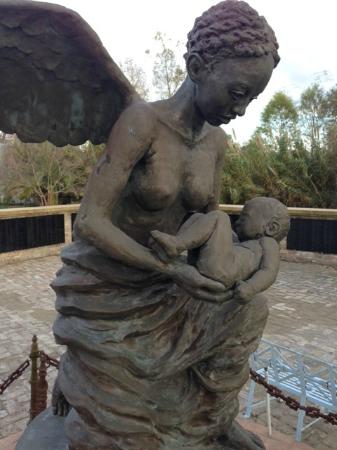“Slavery gets understood as a kind of prehistory to freedom rather than what it really is: the foundation for a country where white supremacy was predicated upon African-American exploitation,” says Walter Johnson, a Harvard professor. “This is still, in many respects, the America of 2015.”
You all may or may not recall that we were invited and taken on a private tour of the Whitney Slavery Museum Plantation last year by the proprietor - creator, John Cummings.
The NY Times Mag did a piece on the Whitney for this weekend's edition of the publication.
Built largely in secret and under decidedly unorthodox circumstances, the Whitney had been turned into a museum dedicated to telling the story of slavery — the first of its kind in the United States.This is not by any means the first slavery museum in North America. I have visited quite a few of them, from slave markets as memorials and learning centers, to restored "quarters" on other plantations, to auction sites and slave jails. There's a large slavery museum in Richmond (along with a Confederacy museum; the Confederacy museum is located within a well-marked historical district -- the slavery museum, well, it's more difficult to access, shall we say?).
However, whatever first inspired Cummings to create this memorial museum out of a Louisiana sugar plantation, I recognize, intimately, what drives him. It's feeling that overwhelming obligation to bring out in an organized, structured, carefully documented public manner -- the revelation of WHAT REALLY HAPPENED that we as individuals and citizens, and as a nation keep hiding and lying about:
. . . . “I started to see slavery and the hangover from slavery everywhere I looked,” he said. As a descendant of Irish laborers, he has no direct ties to slaveholders; still, in a departure from the views held by many Southern whites, Cummings considered the issue a personal one. “If ‘guilt’ is the best word to use, then yes, I feel guilt,” he said. “I mean, you start understanding that the wealth of this part of the world — wealth that has benefited me — was created by some half a million black people who just passed us by. How is it that we don’t acknowledge this?”
The Whitney Plantation is something different, and astonishing. It's art, a gigantic, multi-layered, multi-faceted memorial complex honoring the blood, sweat and grief of the thousands and millions of people, captured, victimized, tortured and held captive to their deaths, their entire lives devoured by estate-prison machines like the Whitney.
After visiting the Whitney Plantation, and then the Angola Prison, which is a fully functioning plantation, made from a plantation owned by the antebellum era's largest, most successful and wealthiest slave trader, what I'd learned about Jefferson and Virginia plantations from the penal colony of Monticello showed in even more disturbing relief.
Located on land where slaves worked for more than a century, in a state where the sight of the Confederate flag is not uncommon, the results are both educational and visceral. An exhibit on the North American slave trade inside the visitors’ center, for instance, is lent particular resonance by its proximity, just a few steps away outside its door, to seven cabins that once housed slaves. From their weathered cypress frames, a dusty path, lined with hulking iron kettles that were used by slaves to boil sugar cane, leads to a grassy clearing dominated by a slave jail — an approach designed so that a visitor’s most memorable glimpse of the white shutters and stately columns of the property’s 220-year-old “Big House” will come through the rusted bars of the squat, rectangular cell. A number of memorials also dot the grounds, including a series of angled granite walls engraved with the names of the 107,000 slaves who spent their lives in Louisiana before 1820. Inspired by Maya Lin’s Vietnam Veterans Memorial in Washington, the memorial lists the names nonalphabetically to mirror the confusion and chaos that defined a slave’s life.
These names have been taken from the database compiled by long-time amiga and colleague, the ground-breaking, pioneering scholar, Gwendolyn Midlo Hall. See her great works, which are now online, "Database for the Study of Afro-Louisiana History and Genealogy" and "Afro-Louisiana History and Genealogy 1719-1820".
Why this museum? Why now? (Why The American Slave Coast: A History of the Slave-breeding Industry? Why now?)
A nation builds museums to understand its own history and to have its history understood by others, to create a common space and language to address collectively what is too difficult to process individually. Forty-eight years after World War II, the United States Holocaust Memorial Museum opened in Washington. A museum dedicated to the Sept. 11 terrorist attacks opened its doors in Lower Manhattan less than 13 years after they occurred. One hundred and fifty years after the end of the Civil War, however, no federally funded museum dedicated to slavery exists, no monument honoring America’s slaves. “It’s something I bring up all the time in my lectures,” says Eric Foner, a Columbia University historian and the author of the Pulitzer Prize-winning “Fiery Trial: Abraham Lincoln and American Slavery.” “If the Germans built a museum dedicated to American slavery before one about their own Holocaust, you’d think they were trying to hide something. As Americans, we haven’t yet figured out how to come to terms with slavery. To some, it’s ancient history. To others, it’s history that isn’t quite history.”The article is a very good one, reflecting, hopefully, the tone of the NY Times Magazine's roll-out of its brand new do-over.






No comments:
Post a Comment